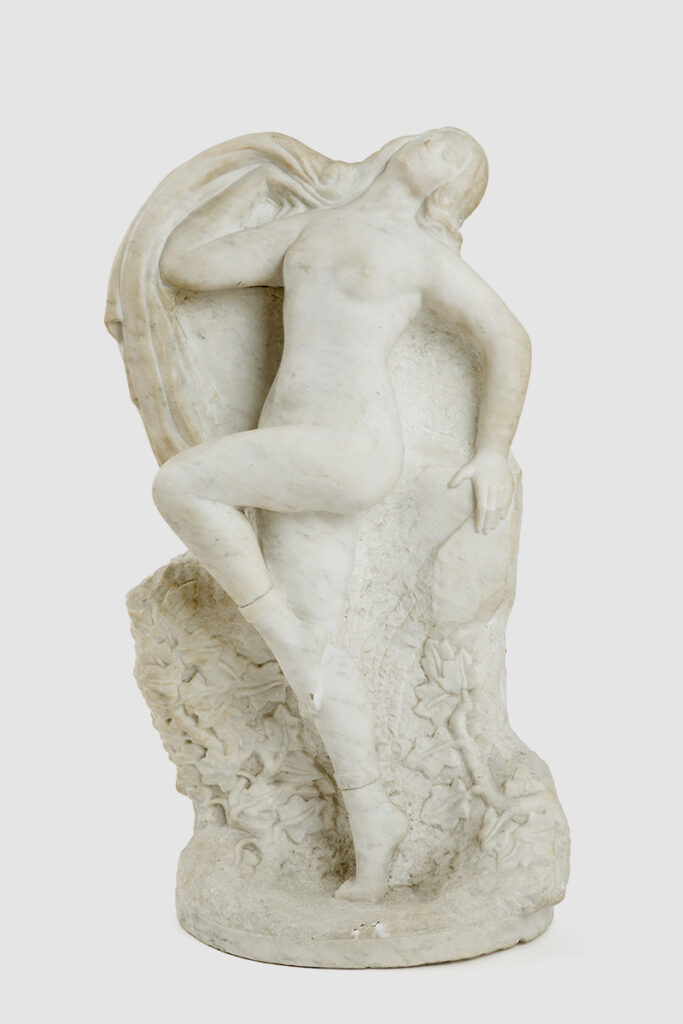The intimacy of Bartfay´s work ´The Dancer´ urges to think about the motif that insipired the artist to create this artwork. The theme was the immortal poem ´The song of songs´. The protagonists are a woman – shepherdess – identified as Shulamite and the king Solomon, and the poem suggests movement from courtship to consummation and how the tender and emotional being who loved her sovereign died for her love. The composition of Bartfay´s work, the cut marble shapes and sensual dance of a girl dancing in a dynamic and rythmic movement, in the deep-felt love, with loose hair, blowing in the rhythm of music. The figure of a girl is anatomically perfect with characteristic touch by Július Bartfay. He was able to penetrate the psychology of the model and give the artwork itself the authenticity. It definitely belongs to the brilliant artworks of his most prolific period in the 1930s.
Július Bartfay entered the Slovak art scene at the beginning of the 1920s. At this time he came across the artwork of an influential French sculptor Émile Antoine Bourdella (1861 – 1929), at whose studio he also studied. Bourdell´s approach found its response in Bartfay´s artwork, especially in the realization of portrayal and figural work. In 1926 he created his self-portrait as well as portraits of many famous music composers, such as Ludwig van Beethoven, Franz Liszt, W.A. Mozart and other scientists and thinkers. While studying his work in more detail, we can also observe the influence by Auguste Rodin (1840 – 1917).
The lifetime work of the prominent representative of Slovak sculpture follows three creative phases. The first one is the portrayal work in which he tries to monumetalize the expression of the sculpture, capturing the mental state and inner tension of the model. The second part of his work is based on the literary and musical motifs in which he personalizes famous literary and musical artworks, also mythological motifs in which the symbol and allegory serve the socially expression of a deep-felt and remelted experience from the artwork. The last phase presents Works with social undertone and belongs to his most convincing ones. They display the critical realism of the author in the context of domestic artistic development and perform an important addition to the socially oriented movement in the Slovak sculpure. The most productive period of the artist were already mentioned 1920s and 1930s in which his thematic and contextual resource were rustic environment, but also the rich historical era of The Great Moravian Empire – he represented different famous historical personalities: Pribina, Koceľ, Svätopluk. In his sculptural work we can find many sacral motifs, too.
The importance of the lifelong work by Július Bartfay embodies his contribution of the dynamic expressionistic elements into the modern Slovak sculpture in the 1920s.
Július Bartfay was born on September 28, 1888 in Nitra. In 1902-04 he studied at the carpenter school led by Anton Köke in Nitra, in 1905-06 he worked in the furniture factory TÉK in Budapest, n 1906-09 he established a cartpenter workshop in Nitra, in 1909-14 he completed his service in the army, 1913-14 worked in Vienna in the Ludwig Bernhard´s furniture factory where he completed a part of the town Vienna decoration for the World Exhibition in Lyon, France. In 1918 he grounded a studio in Farská Str. in Nitra and during the following year organized his first solo exhibition in Nitra. In 1920-23 he took part in a study programe in France at É.A. Bourdell´s studio in Paris, 1921-22 he studied at the Academy de Lagrande Chaumiére in Paris.
In 1923 he returned to Nitra where he stayed until 1926. In the same year he left for a study trip in Rome at the Academy of Fine Arts where he also hired his own studio. After his stay in Rome he opened a studio together with a ceramist Lola Erdész in Vikárska Str. in Nitra. In 1928-30 he attended the second stay in Paris at Bourdell´s Academy and worked at the same time in the Photorelief company. In 1930 he settled in Nitra. He was a member of UBS in Bratislava 1931-39, member of SSVU in Bratislava 1939-45, member of the Union of Slovak Visual Artists in Bratislava 1946-48, member of Slovak Association of Artists in Bratislava from 1950.
Awards
1965 award of the municipality of Nitra for the credits in the development of Nitra
1967 award of the municipality of Nitra
1968 award for excellent work
1973 award by Rad práce
Július Bartfay died on August 25, 1979 in Nitra. He is buried at Slávičie údolie in Bratislava.
Marta Hučková
Bibliography:
HUČKOVÁ, M.: Július Bartfay 1888 – 1979 – lyrik, ktorý prebásňoval skutočnosť. Nitrianska galéria, 2008.
Inventory No.: P-333
Artist: Július Bartfay
Title: The Dancer
Year of origin: 1930
Technique: chipping
Material: marble
Dimensions: 62 × 32 × 15,5 cm
Signature: unsigned
